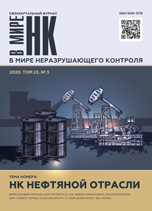Nizhniy Novgorod, Russian Federation
Nizhniy Novgorod, Russian Federation
Nizhniy Novgorod, Russian Federation
Moskva, Russian Federation
Moskva, Russian Federation
Moskva, Russian Federation
Moskva, Russian Federation
Sankt-Peterburg, Russian Federation
Sankt-Peterburg, Russian Federation
The problem of maximum stresses estimation in the weld metal, where the direct measurements are not possible due to the influence of the metal structure on the measurement error, was solved. The influence of features of welding joints manufacturing technology on the structure of the weld metal was also determined. We use several reference welded joints of pipelines at nuclear power plants in our studies. Instrumental estimation of acoustoelasticity parameters in the weld metal in welded joints and in adjacent areas of the base metal was used together with computational modeling of the residual welding stresses distributions. Results obtained demonstrate that the error of stress measurement in the metal in the joint, which is related to the structure of the weld metal, is comparable to the material yield strength. Due to that a direct measurement of the maximum values of welding stresses is not possible. Comparison of results of acoustoelasticity parameters measurements with results of the metal macrostructure studies and mechanical tests allowed us to determine the relationship between peculiarities of structure of the weld metal sections at vertical joints with their tendency to brittle destruction. We propose and justify the NDT method of residual welding stresses in the weld metal. It is based on the principle of residual stresses balancing and employs the results of stress measurements in the base metal by acoustoelasticity. Applicability of non-destructive testing of acoustoelasticity parameters to identify the areas of welded joints with a higher tendency to brittle fracture is also justified.
measurement of mechanical stresses, acoustoelasticity, acoustic anisotropy, weld metal, welding stresses, balancing principle, macrostructure, dendrites, brittle fracture
1. Nikitina N. E. Akustouprugost'. Opyt prakticheskogo primeneniya. - N. Novgorod: TALAM, 2005. - 208 s.
2. GOST R 52890-2007. Kontrol' nerazrushayuschiy. Akusticheskiy metod kontrolya napryazheniy v materiale truboprovodov. Obschie trebovaniya. - M.: Standartinform, 2009.
3. GOST R 55043-2012. Kontrol' nerazrushayuschiy. Opredelenie koefficientov uprugoakusticheskoy svyazi. Obschie trebovaniya. - M.: Standartinform, 2014.
4. Kamyshev A. V., Pasmanik L. A., Smirnov V. A. i dr. Raschetno-instrumental'nyy metod ocenki napryazhenno-deformirovannogo sostoyaniya s opredeleniem silovyh granichnyh usloviy metodom akustouprugosti i ego primenenie dlya analiza povrezhdaemosti SS№111. - Tyazheloe mashinostroenie. 2015. № 1-2. S. 11-18.
5. Kurashkin K. V. Issledovanie akustouprugogo effekta v anizotropnom plasticheski deformiruemom materiale. - Akusticheskiy zhurnal. 2019 T. 65. № 3. S. 382-388.
6. Antonov A. A., Letunovskiy A. P. Vozmozhnosti ocenki ostatochnyh napryazheniy v svarnyh konstrukciyah. - V mire NK. 2018 T. 21. № 1. S. 10-12.
7. PNAEG 7-002-86. Normy rascheta na prochnost' oborudovaniya i truboprovodov AEU. - M.: Gosatomnadzor SSSR, 1986.
8. Elementy oborudovaniya AES. Metodika vypolneniya izmereniy mehanicheskih napryazheniy, voznikayuschih v rezul'tate tehnologicheskih vozdeystviy, metodom akustouprugosti. Svidetel'stvo ob attestacii № 633/17004 ot 16.06.2009.
9. BS 7448-1. Fracture mechanics toughness tests. Part 1: Method for determination of KIc, critical CTOD and critical J values of metallic materials. ISO 12737:2005. Metallic materials - Determination of plane-strain fracture toughness.





